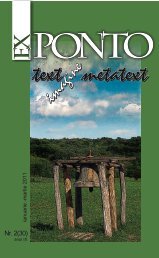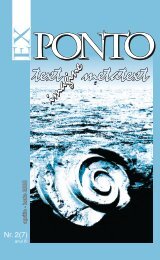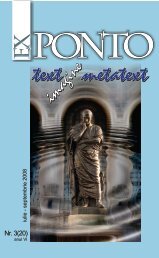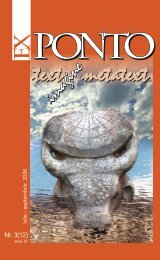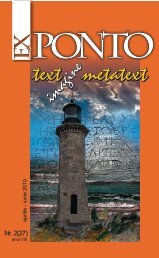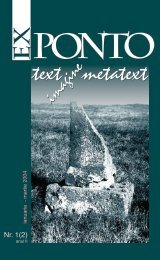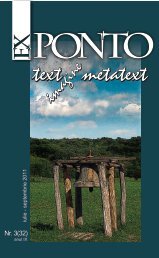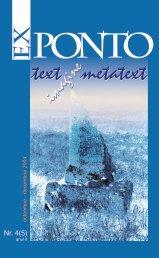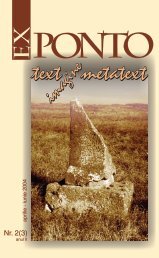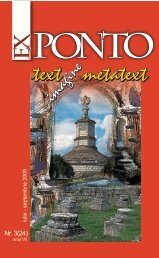Nr. 1 (10) anul IV / ianuarie-martie 2006 - ROMDIDAC
Nr. 1 (10) anul IV / ianuarie-martie 2006 - ROMDIDAC
Nr. 1 (10) anul IV / ianuarie-martie 2006 - ROMDIDAC
Create successful ePaper yourself
Turn your PDF publications into a flip-book with our unique Google optimized e-Paper software.
EX PONTO NR.1, <strong>2006</strong><br />
196<br />
worthy of the right emotion to listen to it properly: „Je ne l’écouterais pas ce<br />
soir, ni sans doute même demain, mais à tel moment où j’aurais du moins<br />
l’illusion d’avoir droit à ce pathetique, ou j’en aurai besoin pour me rappeler<br />
à quel point l’homme peut être innocent, démoli (je songe à It Never Entered<br />
My Mind de Bud) ∂...∑ Et sauvant jusque dans ce malheur l’espoir incapable<br />
de comprendre. Mais je n’en dirai pas plus.” 5<br />
This „je n’en dirai pas plus” is significant in the sense that for him, not<br />
speaking or writing is just as important as coming up with the right word or<br />
note. This is what he so appreciates in Sweets Edison whom he compares<br />
to a „grammarian” rather than a poet, and whom he admires for his exactitude,<br />
balance and grace. As much as he admires the unbridled impatience<br />
and unruly exuberance that he sees in Roy Eldridge, Edison is emblematic<br />
of what Réda considers to be the highest form of craftsmanship: the art of<br />
almost Zen-like precision which, like an arrow, always hits his mark: „Ses mots<br />
justes prennent place dans les phrases sobres et parfaitement équilibrées,<br />
où l’on n’a jamais à chercher quel verbe appelle quel complément.” 6 Indeed,<br />
Réda uses grammatical imagery to underline the similarity between Edison’s<br />
musical art and that of the poet for whom each word must be the exact one,<br />
with no margin for error: „Ce que joue Edison ne laisse pas de marge à l’interpretation.<br />
Car au contraire des musiciens qui ont souvent l’air de broder autour<br />
d’une idée ou de commenter leurs sentiments, il se borne à l’énoncé exact<br />
et suffise de phrases qui ne veulent rien dire d’autre que ce qu’elles disent<br />
et disent leur perfection” (p. 114). Yet, while Réda’s description of Edison’s<br />
concision, borders on the clinical at times he ends his commentary with a<br />
purely emotional and imaginative image: „Cette préeminence de la épure où<br />
l’air circule, discrètement teinté de bleu” (p. 114). With the etherial „air” imagery<br />
that Réda uses so frequently to describe his own floating through Paris<br />
„comme un nuage,” he ends on an ethereal note, as if to corroborate the fact<br />
that, for the poet as for the jazz musician, the lyrical and the disciplined must<br />
go hand in hand.<br />
It is in his writings on Dodo Marmarosa, however, that Réda’s poetic descriptive<br />
skills truly takes off as in Marmorosa, he sees the perfect mixture:<br />
the intensity of the virtuoso and the elliptical qualities of the dreamer. Even<br />
Marmarosa’s nickname, „Dodo,” is replete in metaphorical associations of<br />
flight and whimsy that Réda uses so well to analyse his own activities as a<br />
flâneur: „Il est certain que le virtuose à part aux réussites du poète, qu’il a<br />
pourvu de moyens, et que leur opposition n’apparaîtra pas souvent aussi<br />
touchée. Mais elle explique les flottements typiques d’une manière qui, de<br />
l’indécision même, tire un surcroît de liberté.” 7 Indeed, Marmarosa is a „rare<br />
bird,” as Réda is fond of calling him, perhaps even a sort of jazz soul mate,<br />
as he often describes him in flâneur terms: „De son pas qui sonne clair, il arpente<br />
déjà un paysage qu’on ne distinguera jamais que par échappées et qui<br />
doit tout à la fantaisie du promeneur” (p.257). Pacing, wandering, escaping:<br />
the flâneur’s footsteps are transposed onto Marmarosa’s piano keys, just as<br />
Réda, the poet, seeks out the suburbs in such Jazz inspired works as Beauté<br />
surburbaine (1985). Marmarosa is one who is drawn to the surprise moments<br />
of beauty interspersed within the quotidian. Réda recounts rare anecdotes of<br />
Marmarosa’s contemplating rays of sunlight at the bottom of his emerald green<br />
bathtub, or stopping in the middle of the street in order to listen to a church<br />
bell ring, or to wait for birds to wake up at daybreak. Onomastically, Réda<br />
is taken with Marmarosa’s aviary imagery because he sees in him an artist




